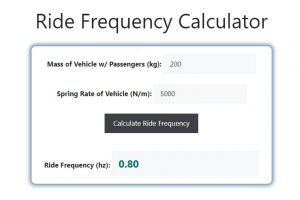About Ride Frequency Calculator (Formula)
In the world of mechanical engineering and amusement park rides, understanding the ride frequency is essential for safety and performance. The Ride Frequency Calculator helps determine the frequency at which a ride oscillates, providing critical data for design and operation. This article will explore the formula used for calculating ride frequency, how to use it, and provide an example along with frequently asked questions.
Formula
The formula to calculate ride frequency is given by:
f = 1 / (2 * π) * √(K / M)
Where:
- f is the ride frequency in hertz (Hz)
- K is the spring constant (stiffness) in newtons per meter (N/m)
- M is the mass of the ride in kilograms (kg)
- π is a constant approximately equal to 3.14159
How to Use
To use the Ride Frequency Calculator, follow these steps:
- Determine the spring constant (K) of the ride’s system.
- Measure the mass (M) of the ride.
- Plug these values into the formula to calculate the ride frequency (f).
- Ensure the result is in hertz (Hz) for frequency interpretation.
Example
Suppose a ride has a spring constant of 5000 N/m and a mass of 200 kg. To find the ride frequency, plug these values into the formula:
f = 1 / (2 * π) * √(5000 / 200)
f = 1 / (2 * 3.14159) * √(25)
f ≈ 1 / 6.28318 * 5
f ≈ 0.796 Hz
Thus, the ride frequency would be approximately 0.796 hertz.

FAQs
- What is ride frequency?
Ride frequency is the rate at which a ride oscillates or moves back and forth, typically measured in hertz (Hz). - Why is ride frequency important?
It is crucial for ensuring the safety and comfort of passengers and for the proper design of the ride. - What units are used in the formula?
The spring constant (K) is in newtons per meter (N/m), mass (M) is in kilograms (kg), and frequency (f) is in hertz (Hz). - What does the spring constant represent?
The spring constant indicates the stiffness of the system; a higher value means a stiffer spring. - How do I measure the spring constant of a ride?
The spring constant can often be found in the ride specifications or determined experimentally by applying a force and measuring displacement. - Can I use this formula for any type of ride?
This formula is typically applicable to rides that have a spring-like behavior, such as roller coasters or pendulum rides. - What factors can affect ride frequency?
Changes in mass, spring constant, and external forces can all influence the ride frequency. - How can I increase the ride frequency?
You can increase the ride frequency by either increasing the spring constant (making the system stiffer) or reducing the mass of the ride. - Is ride frequency related to ride safety?
Yes, understanding the frequency can help prevent resonant frequencies that might lead to mechanical failure or discomfort for riders. - What is resonance in relation to ride frequency?
Resonance occurs when the frequency of external forces matches the natural frequency of the ride, potentially leading to excessive vibrations and safety risks. - Can ride frequency change over time?
Yes, wear and tear on components can affect the spring constant and overall mass, thus altering the frequency. - Is there a standard frequency for amusement rides?
There is no one-size-fits-all frequency; it varies widely depending on the design and purpose of the ride. - How is ride frequency measured in practice?
Ride frequency can be measured using sensors or accelerometers during operation to monitor oscillations. - What should I do if the calculated frequency is too high?
You may need to adjust the mass or spring constant to ensure the frequency is within safe limits for the design of the ride. - Can this formula help in designing new rides?
Yes, it provides critical insights into how a ride will behave, helping engineers design for safety and performance. - What is the relationship between frequency and ride comfort?
A ride operating at its designed frequency is generally more comfortable, while deviations can lead to discomfort or even motion sickness. - What kind of maintenance affects ride frequency?
Regular maintenance of springs, mass components, and structural integrity can help maintain the designed frequency. - Can I use this formula for vehicles?
The formula can be adapted for vehicles with spring systems, like suspension, to analyze their frequency response. - What is the maximum frequency for rides?
Maximum frequency depends on design limits and comfort levels but must always consider safety and passenger experience. - Are there online calculators for ride frequency?
Yes, many engineering and amusement ride design websites provide online calculators for ride frequency based on the given formula.
Conclusion
The Ride Frequency Calculator is an essential tool for engineers and designers in the amusement ride industry. By using the formula outlined in this article, you can accurately determine the ride frequency, ensuring that rides are both safe and enjoyable for all passengers. Understanding the principles of ride frequency allows for better design decisions, leading to enhanced performance and passenger satisfaction.